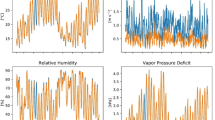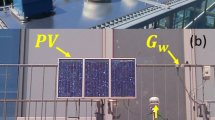Abstract
Trees play an important role in mitigating heat stress on hot summer days, mainly due to their ability to provide shade. However, an important issue is also the reduction of solar radiation caused by trees in winter, in particular at high latitudes. In this study, we examine the transmissivity of total and direct solar radiation through crowns of single street trees in Göteborg, Sweden. One coniferous and four deciduous trees of species common in northern European cities were selected for case study. Radiation measurements were conducted on nine clear days in 2011–2012 in foliated and leafless tree conditions using two sunshine pyranometers—one located in shade of a tree and the other one on the roof of an adjacent building. The measurements showed a significant reduction of total and direct shortwave radiation in the shade of the studied trees, both foliated and leafless. Average transmissivity of direct solar radiation through the foliated and defoliated tree crowns ranged from 1.3 to 5.3 % and from 40.2 to 51.9 %, respectively. The results confirm the potential of a single urban tree to reduce heat stress in urban environment. However, the relatively low transmissivity through defoliated trees should be considered while planning street trees in high latitude cities, where the solar access in winter is limited. The results were used for parameterisation of SOLWEIG model for a better estimation of the mean radiant temperature (Tmrt). Measured values of transmissivity of solar radiation through both foliated and leafless trees were found to improve the model performance.








Similar content being viewed by others
References
Akbari H, Pomerantz M, Taha H (2001) Cool surfaces and shade trees to reduce energy use and improve air quality in urban areas. Solar Energy 70(3):295–310
Ali-Toudert F, Mayer H (2005) Thermal comfort in urban streets with trees under hot summer conditions. In: Proc. 22th Conference on Passive and Low Energy Architecture (PLEA), Beirut, Lebanon, 13–16 November 2005. pp 699–704
Anderson MC (1964) Studies of the Woodland light climate. 1. The photographic computation of light conditions. J Ecol 52(1):27–41
Bowler DE, Buyung-Ali L, Knight TM, Pullin AS (2010) Urban greening to cool towns and cities: a systematic review of the empirical evidence. Landsc Urban Plann 97(3):147–155
Bruse M (2004) ENVI-met 3.0: Updated Model Overview. http://www.envi-met.com/documents/papers/overview30.pdf. Accessed on 7 January 2013
Bruse M, Fleer H (1998) Simulating surface-plant-air interactions inside urban environments with a three dimensional numerical model. Environ Model Software 13(3–4):373–384
Cantón MA, Cortegoso JL, Derosa C (1994) Solar permeability of urban trees in cities of western Argentina. Energy and Buildings 20(3):219–230
Chapman L (2007) Potential applications of near-infrared hemispherical imagery in forest environments. Agricultural & Forest Meteorology 143:151–156
de Abreu LV, Labaki LC (2008) 648: Evaluation of the radius of influence of different arboreal species on microclimate provided by vegetation. In: PLEA 2008 - 25th Conference on Passive and Low Energy Architecture, Dublin
Dimoudi A, Nikolopoulou M (2003) Vegetation in the urban environment: microclimatic analysis and benefits. Energy and Buildings 35(1):69–76
Dragoni D, Schmid HP, Wayson CA, Potter H, Grimmond CSB, Randolph JC (2011) Evidence of increased net ecosystem productivity associated with a longer vegetated season in a deciduous forest in south-central Indiana, USA. Global Change Biol 17(2):886–897
Gardner TJ, Sydnor TD (1984) Interception of summer and winter insolation by 5 shade tree species. J Am Soc Hortic Sci 109(4):448–450
Gay LW, Knoerr KR, Braaten MO (1971) Solar radiation variability on the floor of a pine plantation. Agr Meteorol 8:39–60
Hardy JP, Melloh R, Koenig G, Marks D, Winstral A, Pomeroy JW, Link T (2004) Solar radiation transmission through conifer canopies. Agric For Meteorol 126(3–4):257–270
Heisler GM (1986) Effects of individual trees on the solar-radiation climate of small buildings. Urban Ecol 9(3–4):337–359
Jauregui E (1991) Influence of a large urban park on temperature and convective precipitation in a tropical city. Energy and Buildings 15(3–4):457–463
Liakatas A, Proutsos N, Alexandris S (2002) Optical properties affecting the radiant energy of an oak forest. Meteorol Appl 9(4):433–436
Lindberg F (2012) The SOLWEIG-model. http://www.gvc.gu.se/Forskning/klimat/stadsklimat/gucg/software/solweig/. Accessed on 7 January 2013
Lindberg F, Grimmond CSB (2011) The influence of vegetation and building morphology on shadow patterns and mean radiant temperatures in urban areas: model development and evaluation. Theor Appl Climatol 105(3–4):311–323
Lindberg F, Holmer B, Thorsson S (2008) SOLWEIG 1.0—modelling spatial variations of 3D radiant fluxes and mean radiant temperature in complex urban settings. Int J Biometeorol 52(7):697–713
Matzarakis A, Rutz F, Mayer H (2007) Modelling radiation fluxes in simple and complex environments—application of the RayMan model. Int J Biometeorol 51(4):323–334
Mayer H, Hoppe P (1987) Thermal comfort of man in different urban environments. Theor Appl Climatol 38(1):43–49
Mayer H, Kuppe S, Holst J, Imbery F, Matzarakis A (2009) Human thermal comfort below the canopy of street trees on a typical Central European summer day. Ber Meteor Inst Univ Freiburg 18:211–219
Ni WG, Li XW, Woodcock CE, Roujean JL, Davis RE (1997) Transmission of solar radiation in boreal conifer forests: measurements and models. J Geophys Res-Atmos 102(D24):29555–29566
Norman JM, Jarvis PG (1974) Photosynthesis in Sitka Spruce (Picea-sitchensis (Bong.) Carr.). III. Measurements of canopy structure and interception of radiation. J Appl Ecol 11(1):375–398
Oke TR (1987) Boundary layer climates. 2nd edn. Methuen, London; New York
Oke TR (1989) The micrometeorology of the urban forest. Philosophical Transactions of the Royal Society of London Series B-Biological Sciences 324(1223):335–349
Pomeroy JW, Dion K (1996) Winter radiation extinction and reflection in a boreal pine canopy: measurements and modelling. Hydrological Processes 10(12):1591–1608
Rich PM, Clark DB, Clark DA, Oberbauer SF (1993) Long-term study of solar-radiation regimes in a tropical wet forest using quantum sensors and hemispherical photography. Agr Forest Meteorol 65(1–2):107–127
Robitu M, Musy M, Inard C, Groleau D (2006) Modeling the influence of vegetation and water pond on urban microclimate. Solar Energy 80(4):435–447
Shashua-Bar L, Hoffman ME (2000) Vegetation as a climatic component in the design of an urban street—an empirical model for predicting the cooling effect of urban green areas with trees. Energy and Buildings 31(3):221–235
Shashua-Bar L, Pearlmutter D, Erell E (2011) The influence of trees and grass on outdoor thermal comfort in a hot-arid environment. Int J Climatol 31(10):1498–1506
Simpson JR, McPherson EG (1996) Potential of tree shade for reducing residential energy use in California. J Arboric 22(1):10–18
Thayer RL, Maeda BT (1985) Measuring street tree impact on solar performance: a five-climate computer modeling study. J Arboric 11:1–11
Thorsson S, Lindberg F, Eliasson I, Holmer B (2007) Different methods for estimating the mean radiant temperature in an outdoor urban setting. Int J Climatol 27(14):1983–1993
Thorsson S, Lindberg F, Bjorklund J, Holmer B, Rayner D (2011) Potential changes in outdoor thermal comfort conditions in Gothenburg, Sweden due to climate change: the influence of urban geometry. Int J Climatol 31(2):324–335
Upmanis H, Eliasson I, Lindqvist S (1998) The influence of green areas on nocturnal temperatures in a high latitude city (Goteborg, Sweden). Int J Climatol 18(6):681–700
Wilkinson DM (1991) Can photographic methods be used for measuring the light attenuation characteristics of trees in leaf? Landsc Urban Plann 20(4):347–349
Wood J (2007) User Manual for the Sunshine Pyranometer Type SPN1. http://www.delta-t.co.uk/product-downloads.asp?$=Product%20Manuals. Accessed on 26 July 2013
Yates D, McKennan G (1988) Solar architecture and light attenuation by trees: conflict or compromise? Landscape Research 13(1):19–23
Youngberg RJ (1983) Shading effects of deciduous trees. J Arboric 9(11):295–297
Zipperer WC, Sisinni SM, Pouyat RV, Foresman TW (1997) Urban tree cover: an ecological perspective. Urban Ecosyst 1:229–246
Acknowledgments
The project is being funded by the Swedish Research Council Formas, the Swedish Energy Agency, the Swedish Environmental Protection Agency, the Swedish National Heritage Board and the Swedish Transport Administration.
Author information
Authors and Affiliations
Corresponding author
Rights and permissions
About this article
Cite this article
Konarska, J., Lindberg, F., Larsson, A. et al. Transmissivity of solar radiation through crowns of single urban trees—application for outdoor thermal comfort modelling. Theor Appl Climatol 117, 363–376 (2014). https://doi.org/10.1007/s00704-013-1000-3
Received:
Accepted:
Published:
Issue Date:
DOI: https://doi.org/10.1007/s00704-013-1000-3




